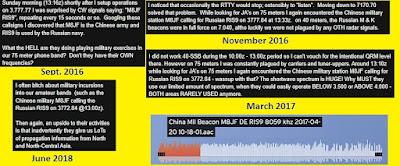Since October, WQ6X has been toying with the idea of double-and-triple OP'ing various radiosport contests, altho I have run up to 5 and 6 different contest GiGs in one weekend many times before. While I was hoping to double-op the JIDX contest, reading the rules closely brought be the realization that in JIDX contests, double-OP'ing is expressly not-allowed. For the 2nd contest weekend in November, the available choices were the
WAE RTTY contest, the
JIDX Ssb contest and the
OK/OM Cw contest.
As a multi-op operation, NX6T has earned many Top-Mop plaques, for both the Cw and Ssb JIDX GiGs. Coincidentally, the WAE RTTY GiG offers a 48-hour opportunity to run RTTY during JIDX
off-periods, which turned out to NoT be a problem as the Japanese turnout in their own JIDX
contest was the POORest we've experienced in many years. Seeing JH4UYB's callsign on
all the WAE-RTTY bandmaps led me to theorize that there were more JA stations running
RTTY than Ssb in their own contest
Fortunately, the Yaesu FT-2000 transceiver is capable of running full-duty 100-watt RTTY
as well as clean Ssb. Being a relatively recent addition to the WQ6X operation, this will
be the 1st WAE-RTTY GiG using this circa 2009 full-featured radio.
Recently, I swapped in a new cable for the Rig-Expert rig control, only to discover that for RTTY
it doesn't properly forward soundcard data to the transceiver. After more than an hour of futzing-around, I discovered that I could send the soundcard data to the speaker system in the 33" SONY monitor and tap the headphone audio from there, feeding it to the open jack on the back of the
FT-2000 - Voila! Instant RTTY. The audio was actually TOO strong, requiring a dial-back of
the microphone audio-level and ensuring the speech compression is turned off.
With only a handful of QSOs in the RTTY log, I took a sleep break and then took over our newer
"Cliffside" station in Southern California. The antennas for this site is "Tower 1" from the site in Fallbrook that NX6T used to run contests from, now parked at the Cliffside location. We've not
yet setup any power amplifiers at this location, relegating us to run the JIDX GiG as a Multi-Single
low power (LP) station. Our bay area rival (K3EST) was [hopefully] running as a Multi-2 station.
Because the JA turnout was so poor, it turns out that we worked everyone could hear.
"Hearing" was our problem, not them being able to hear us. Having used an amplifier
would've made little difference.
For JIDX, on Saturday, the 2am slot ALWAYS flushes out the weird JAMMERS; not surprising when you consider that Billy-Bob (end his brother Barney) is just waking up on the east coast and looking for someone to antagonize. The Jammer for this GiG was playing-back a delayed recording of my CQ call, but with a weird echo on it. Luckily, Billy-Bob quickly got BORED with this and went back
to bed. Ya' gotta acknowledge this guy's amazing use of technology. Wouldn't it be nice if it could
be used for something constructive?
At 13:50z just before I shut things down for the morning, my run frequency became inundated with data bursts and a "WHOOP" sound. Stations moving in on the run frequency prompted jumping around between 7.175, 7.176, 7.177 and then back again. The weird thing was hearing the famed JE1CKA running a JIDX frequency on 7124.10, with virtually no takers. How could there be?
USA stations are not allowed to transmit Ssb below 7.125 - OOPS. If he absolutely wanted to,
he could run-SPLIT, listening above 7.125.
Because a successful WAE GiG involves the successful of transmission of QTC "books"
(essentially, header messages about QSOs made previously), finding non-North American
openings at the precise time are CRUCIAL to delivering QTC traffic; there's nothing worse
than ending any WAE contest with a significant number of undelivered QTC messages.
As Saturday evening wore, on the band segments seemed to thin out in W6-Land, altho the
bandmap was consistently loaded w/EU SPOTS (spotted by other EU stations). Out of boredom,
I noticed that the OK/OM contest was in full operation, at least on 40 meters (as 20-meters was dead on the West coast). Seeing activity prompted me to configure a log for this GiG and make a few calls. After 2-QSOs, the remaining spot-entries were spots by other EU stations, which of course does us no good. At least by submitting a 2-QSO 40-meter log, I was able to post a 3-contest weekend on the 3830-Scores Website for
WQ6X.
Running the Sunday morning shift for the last 3 contest hours (from 2am to 5am) was a SLOW grind, altho at least more QSOs were made than N6KI's 5-QSO 2.5-hour shift before me. I couldn't wait for the 5am contest-end, rescuing me from Billy-Bob, his brother Barney and their cousins Bubba and Bozo who wanted to ragchew and didn't care that anyone was already using their "favorite frequencies" ("we've been meeting on this frequency every Sunday morning for the last 10 years,
and YOU should already know that".). While the Shorty-40 yagi was pointed at 310-degrees to Asia, with only a 20-db F/B ratio, those idiots (running kilowatts to QSO 150-miles away) were pointing RIGHT AT US.
After some sleep, the rest of the WAE RTTY contest was spent mostly on 10- and 15-meters running frequencies (my CQ message said "I have QTC") while desperately trying to dump QTC traffic to those stations eager to relieve me of 1-QTC books. When it was all over, I was stuck with 52 undelivered QTC messages; about the same as last year - Bummer DewD!
When it was all over, according to the online Scoreboard, WQ6X ended up in 72nd place worldwide.
DiD YOU work the WAE RTTY and/or JIDX Ssb contest?
Is WQ6X (or NX6T) in YOUR Log?












.Jpg)


%20STATs.Jpg)
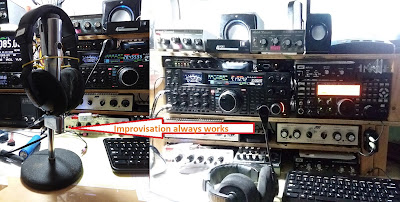




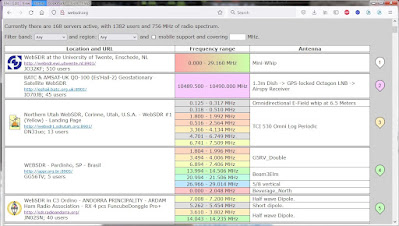
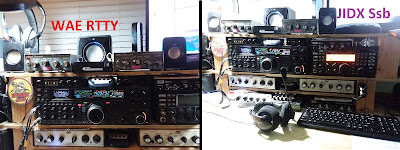




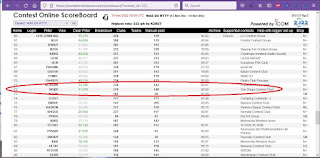

.Jpg)

.Jpg)







%20Collage.Jpg)
.Jpg)



.Jpg)


